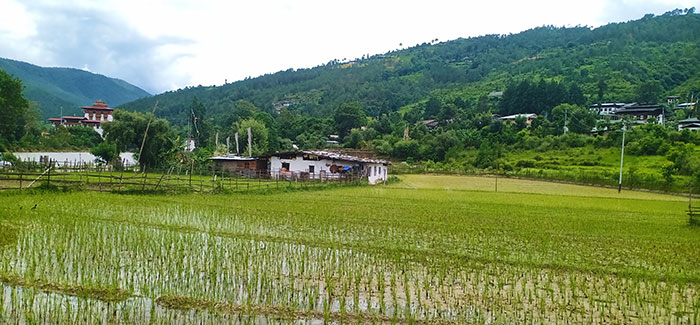Phurpa Lhamo | Punakha
In 2019, when the Pazaps at the Punakha Dromchoe were reenacting the battle against the Tibetans, more than 20 men gathered at Choki Zam’s 16-decimal land in Changyul.
There wasn’t much time. Within the three-day dromchoe holiday, Choki and the hired workers had to finish building a temporary house.
For over seven years, Choki Zam, her husband Kinley Wangdi, and their daughter had been living in a hut built on her sister’s land. In 2016, when her sister asked her to move out so she could demolish the house and cultivate the land, Choki Zam found herself homeless. Renting an apartment was beyond the reach of the family.
“We then planned to build a house on the land we own,” Choki Zam said.
According to section 167 of the Land Act of Bhutan 2007, a landowner with only inherited Chhuzhing (wetland) in his or her thram may apply for 50 decimal in rural areas from such Chhuzhing to the local authority for conversion of Chhuzhing to a residential land.
The couple submitted their application to convert the 16-decimal wetland to residential land in 2016. For the next two years, the couple made rounds—from the gewog to dzongkhag office, to the municipal and to the agriculture sector. After years of waiting, the couple, desperate to find home, resorted to unauthorised construction of the house. In haste, the house was built without a foundation.
Two days after the structure was complete, the couple received a notice from the municipal office in Punakha regarding the unauthorised construction.
“We were scared to even respond to the notice,” Choki Zam said. The house is always musty. The floor is damp most times and fungus grows on clothes. “We have spent a lot on the house.”
The couple spent around Nu 600,000 to build the single-storey house. Apart from Nu 200,000, which the couple had saved, they borrowed money from the villagers. She has today repaid Nu 100,000 by selling chilies and another Nu 50,000 by making mekhu (crispy rice crackers).
Kinley Wangdi said that when he first requested for land conversion he had hoped to get a housing loan. But without the approval to convert the land, the loan was not granted. “Now we don’t even have access to basic facilities. We drink from the river.”
According to the Changyul-Thara Tshogpa Namgay Bidha, over 30 households in the chiwog had requested for land conversion. “We want to help but we cannot do anything. We don’t have the authority. I feel that land conversion should be approved for those who inherited the land. Situation is desperate.”
Forty-two-year-old Dema has been living in a rented apartment for over 15 years. Six years ago, when she inherited 16-decimal land from her parents, she wanted to build a house for herself.
“We put up the application but were told that it couldn’t be approved,” Dema said.
Today, with her husband working on a daily wage at construction sites, the couple pays a rent of Nu 5,000 monthly. They frequently delay paying the rent.
What stops the conversion approval?
The dzongkhag administration officials are aware of the issue.
According to Dzongkhag Land Record Officer, Namgay Dorji, land record officials verified the ownership of the land, quantity of the land and studied whether there was encroachment on the government land before the documents were further verified.
Field survey to create maps is also done by the land record section.
While the land record section verifies documents, a majority of the applications to convert wetland to residential land in Changyul are on hold due to the Punakha Structure Plan and the Dzong Management Plan.
The Punakha Structure Plan was introduced in 2016 by the works and human settlement ministry and the Dzong Management Plan by the Department of Culture (DoC) in 2018.
According to an official, the main purpose of the Punakha Structure Plan and the Dzong Management Plan is to control the settlement density near the dzong.
He added that in the early 1990s, to maintain the sanctity of the dzong, the commercial area was relocated to Khuruthang. “The whole dzong area is an important heritage site. If we had massive structures, the cultural landscape would be lost. So we are trying to retrieve the area by decreasing the density.”
Parts of Changyul, the steep area facing the Punakha Dzong, and the thromde area are today included in the Punakha Structure Plan.
This plan identifies the settlement in front of the Punakha Dzong as urban village (UV2). This means, individually, a person would be allowed to occupy 20 percent of its land as residential area. Further, the maximum allowable floor height is two floors in the area.
The Punakha Structure Plan is expected to help conserve significant cultural landscape, protecting and enhancing the sanctity of religious sites and the cultural heritage, and conserving and enhancing the traditional villages and settlements in order to maintain the unique identity of Punakha, among others.
An official said that the Dzong Management Plan complimented the Punakha Structure Plan. There are guidelines on the construction materials used and the number of floors of the buildings built in the areas identified as buffer zone 2 and 3.
In buffer zone 1, which includes the surroundings of the dzong, construction is restricted. “Our objective is to keep the density low but we also need to give a solution to the people. So we are today segregating cases to find a solution to it.”
DoC, human settlement ministry and the dzongkhag officials are yet to deliberate on the issue. A uniform guideline would be developed and incentives for the affected households would be discussed.


